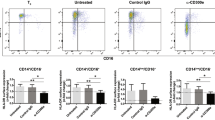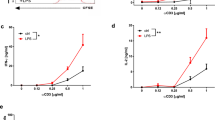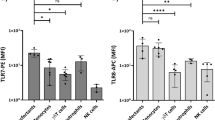Abstract
Toll-like receptors (TLRs) act to sense the environment for microbial products and submit danger signals to antigen-presenting cells (APCs) resulting in activation of complex immune responses. In this study, we analyzed the function of human monocyte-derived APCs generated in vitro in the presence of interleukin (IL)-10 upon activation by TLR ligands. Exposure of these APCs to IL-10 resulted in a skewed phenotypic maturation in response to stimuli provided by the TLR ligands, a reduced cytokine production, such as IL-12, IL-6 or tumor necrosis factor-α, and impaired capacity to stimulate T-cell activation. Furthermore, CCR7 upregulation in APCs exposed to TLR stimulation as well as migration towards CCL19/MIP-3β were strongly reduced. IL-10 was found to downregulate MyD88, IRAK1 (IL-1 receptor-associated kinase) and tumor necrosis factor receptor-associated factor 6, essential adaptor molecules for TLR signaling, and to decrease TLR-induced nuclear expression of the nuclear factor-κB transcription factors c-Rel and Rel-B as well as interferon regulatory factor (IRF)-3 and IRF-8. This was not due to the inhibition of the mitogen-activated protein kinase pathway, but was rather mediated by the blockage of the PI3K signaling cascade. Interestingly, the inhibition of proteins involved in TLR signaling, such as MyD88, IRAK1 and mammalian target of rapamycin, was due to a selective post-transcriptional regulation.
This is a preview of subscription content, access via your institution
Access options
Subscribe to this journal
Receive 12 print issues and online access
$259.00 per year
only $21.58 per issue
Buy this article
- Purchase on Springer Link
- Instant access to full article PDF
Prices may be subject to local taxes which are calculated during checkout







Similar content being viewed by others
References
Banchereau J, Steinman RM . Dendritic cells and the control of immunity. Nature 1998; 392: 245–252.
Kawai T, Akira S . TLR signaling. Cell Death Differ 2006; 13: 816–825.
Li Q, Verma IM . NF-kappaB regulation in the immune system. Nat Rev Immunol 2002; 2: 725–734.
Foletta VC, Segal DH, Cohen DR . Transcriptional regulation in the immune system: all roads lead to AP-1. J Leukoc Biol 1998; 63: 139–152.
Fernandez-Botran R, Sanders VM, Mosmann TR, Vitetta ES . Lymphokine-mediated regulation of the proliferative response of clones of T helper 1 and T helper 2 cells. J Exp Med 1988; 168: 543–558.
Allavena P, Piemonti L, Longoni D, Bernasconi S, Stoppacciaro A, Ruco L et al. IL-10 prevents the differentiation of monocytes to dendritic cells but promotes their maturation to macrophages. Eur J Immunol 1998; 28: 359–369.
Steinbrink K, Wolfl M, Jonuleit H, Knop J, Enk AH . Induction of tolerance by IL-10-treated dendritic cells. J Immunol 1997; 159: 4772–4780.
Brossart P, Zobywalski A, Grünebach F, Behnke L, Stuhler G, Reichardt VL et al. Tumor necrosis factor alpha and CD40 ligand antagonize the inhibitory effects of interleukin 10 on T-cell stimulatory capacity of dendritic cells. Cancer Res 2000; 60: 4485–4492.
Allavena P, Piemonti L, Longoni D, Bernasconi S, Stoppacciaro A, Ruco L et al. IL-10 prevents the generation of dendritic cells from CD14+ blood monocytes, promotes the differentiation to mature macrophages and stimulates endocytosis of FITC-dextran. Adv Exp Med Biol 1997; 417: 323–327.
Enk AH, Angeloni VL, Udey MC, Katz SI . Inhibition of Langerhans cell antigen-presenting function by IL-10. A role for IL-10 in induction of tolerance. J Immunol 1993; 151: 2390–2398.
Steinbrink K, Jonuleit H, Müller G, Schuler G, Knop J, Enk AH . Interleukin-10-treated human dendritic cells induce a melanoma-antigen-specific anergy in CD8(+) T cells resulting in a failure to lyse tumor cells. Blood 1999; 93: 1634–1642.
Wirths S, Reichert J, Grünebach F, Brossart P . Activated CD8+ T lymphocytes induce differentiation of monocytes to dendritic cells and restore the stimulatory capacity of interleukin 10-treated antigen-presenting cells. Cancer Res 2002; 62: 5065–5068.
Wang P, Wu P, Siegel MI, Egan RW, Billah MM . Interleukin (IL)-10 inhibits nuclear factor kappa B (NF kappa B) activation in human monocytes. IL-10 and IL-4 suppress cytokine synthesis by different mechanisms. J Biol Chem 1995; 270: 9558–9563.
Bhattacharyya S, Sen P, Wallet M, Long B, Baldwin Jr AS, Tisch R . Immunoregulation of dendritic cells by IL-10 is mediated through suppression of the PI3K/Akt pathway and of IkappaB kinase activity. Blood 2004; 104: 1100–1109.
Riley JK, Takeda K, Akira S, Schreiber RD . Interleukin-10 receptor signaling through the JAK-STAT pathway. Requirement for two distinct receptor-derived signals for anti-inflammatory action. J Biol Chem 1999; 274: 16513–16521.
Inoki K, Corradetti MN, Guan KL . Dysregulation of the TSC-mTOR pathway in human disease. Nat Genet 2005; 37: 19–24.
Rommel C, Clarke BA, Zimmermann S, Nunez L, Rossman R, Reid K et al. Differentiation stage-specific inhibition of the Raf-MEK-ERK pathway by Akt. Science 1999; 286: 1738–1741.
Brossart P, Grünebach F, Stuhler G, Reichardt VL, Mohle R, Kanz L et al. Generation of functional human dendritic cells from adherent peripheral blood monocytes by CD40 ligation in the absence of granulocyte-macrophage colony-stimulating factor. Blood 1998; 92: 4238–4247.
Bringmann A, Schmidt SM, Weck MM, Brauer KM, von Schwarzenberg K, Werth D et al. Zoledronic acid inhibits the function of Toll-like receptor 4 ligand activated monocyte-derived dendritic cells. Leukemia 2007; 21: 732–738.
Nencioni A, Lauber K, Grünebach F, Van Parijs L, Denzlinger C, Wesselborg S et al. Cyclopentenone prostaglandins induce lymphocyte apoptosis by activating the mitochondrial apoptosis pathway independent of external death receptor signaling. J Immunol 2003; 171: 5148–5156.
Kadowaki N, Ho S, Antonenko S, Malefyt RW, Kastelein RA, Bazan F et al. Subsets of human dendritic cell precursors express different toll-like receptors and respond to different microbial antigens. J Exp Med 2001; 194: 863–869.
Schag K, Schmidt SM, Müller MR, Weinschenk T, Appel S, Weck MM et al. Identification of C-met oncogene as a broadly expressed tumor-associated antigen recognized by cytotoxic T-lymphocytes. Clin Cancer Res 2004; 10: 3658–3666.
Boss CN, Grünebach F, Brauer K, Hantschel M, Mirakaj V, Weinschenk T et al. Identification and characterization of T-cell epitopes deduced from RGS5, a novel broadly expressed tumor antigen. Clin Cancer Res 2007; 13: 3347–3355.
Gunn MD . Chemokine mediated control of dendritic cell migration and function. Semin Immunol 2003; 15: 271–276.
Medzhitov R, Preston-Hurlburt P, Kopp E, Stadlen A, Chen C, Ghosh S et al. MyD88 is an adaptor protein in the hToll/IL-1 receptor family signaling pathways. Mol Cell 1998; 2: 253–258.
Ghosh S, May MJ, Kopp EB . NF-kappa B and Rel proteins: evolutionarily conserved mediators of immune responses. Annu Rev Immunol 1998; 16: 225–260.
Ouaaz F, Arron J, Zheng Y, Choi Y, Beg AA . Dendritic cell development and survival require distinct NF-kappaB subunits. Immunity 2002; 16: 257–270.
Baldwin Jr AS . The NF-kappa B and I kappa B proteins: new discoveries and insights. Annu Rev Immunol 1996; 14: 649–683.
Sharma S, tenOever BR, Grandvaux N, Zhou GP, Lin R, Hiscott J . Triggering the interferon antiviral response through an IKK-related pathway. Science 2003; 300: 1148–1151.
Fitzgerald KA, McWhirter SM, Faia KL, Rowe DC, Latz E, Golenbock DT et al. IKKepsilon and TBK1 are essential components of the IRF3 signaling pathway. Nat Immunol 2003; 4: 491–496.
Tsujimura H, Tamura T, Kong HJ, Nishiyama A, Ishii KJ, Klinman DM et al. Toll-like receptor 9 signaling activates NF-kappaB through IFN regulatory factor-8/IFN consensus sequence binding protein in dendritic cells. J Immunol 2004; 172: 6820–6827.
Appel S, Bringmann A, Grünebach F, Weck MM, Bauer J, Brossart P . Epithelial-specific transcription factor ESE-3 is involved in the development of monocyte-derived DCs. Blood 2006; 107: 3265–3270.
Tugores A, Le J, Sorokina I, Snijders AJ, Duyao M, Reddy PS et al. The epithelium-specific ETS protein EHF/ESE-3 is a context-dependent transcriptional repressor downstream of MAPK signaling cascades. J Biol Chem 2001; 276: 20397–20406.
Chung JS, Sato K, Dougherty II, Cruz Jr PD, Ariizumi K . DC-HIL is a negative regulator of T lymphocyte activation. Blood 2007; 109: 4320–4327.
Banchereau J, Briere F, Caux C, Davoust J, Lebecque S, Liu YJ et al. Immunobiology of dendritic cells. Annu Rev Immunol 2000; 18: 767–811.
Chapuis F, Rosenzwajg M, Yagello M, Ekman M, Biberfeld P, Gluckman JC . Differentiation of human dendritic cells from monocytes in vitro. Eur J Immunol 1997; 27: 431–441.
Cella M, Sallusto F, Lanzavecchia A . Origin, maturation and antigen presenting function of dendritic cells. Curr Opin Immunol 1997; 9: 10–16.
Takeda K, Kaisho T, Akira S . Toll-like receptors. Annu Rev Immunol 2003; 21: 335–376.
Iwasaki A, Medzhitov R . Toll-like receptor control of the adaptive immune responses. Nat Immunol 2004; 5: 987–995.
Akira S, Takeda K . Toll-like receptor signalling. Nat Rev Immunol 2004; 4: 499–511.
Fiorentino DF, Bond MW, Mosmann TR . Two types of mouse T helper cell. IV. Th2 clones secrete a factor that inhibits cytokine production by Th1 clones. J Exp Med 1989; 170: 2081–2095.
Fiorentino DF, Zlotnik A, Vieira P, Mosmann TR, Howard M, Moore KW et al. IL-10 acts on the antigen-presenting cell to inhibit cytokine production by Th1 cells. J Immunol 1991; 146: 3444–3451.
Buelens C, Verhasselt V, De Groote D, Thielemans K, Goldman M, Willems F . Human dendritic cell responses to lipopolysaccharide and CD40 ligation are differentially regulated by interleukin-10. Eur J Immunol 1997; 27: 1848–1852.
Corinti S, Albanesi C, la Sala A, Pastore S, Girolomoni G . Regulatory activity of autocrine IL-10 on dendritic cell functions. J Immunol 2001; 166: 4312–4318.
De Smedt T, Van Mechelen M, De Becker G, Urbain J, Leo O, Moser M . Effect of interleukin-10 on dendritic cell maturation and function. Eur J Immunol 1997; 27: 1229–1235.
O'Sullivan BJ, Thomas R . CD40 ligation conditions dendritic cell antigen-presenting function through sustained activation of NF-kappaB. J Immunol 2002; 168: 5491–5498.
Ding L, Linsley PS, Huang LY, Germain RN, Shevach EM . IL-10 inhibits macrophage costimulatory activity by selectively inhibiting the up-regulation of B7 expression. J Immunol 1993; 151: 1224–1234.
Willems F, Marchant A, Delville JP, Gerard C, Delvaux A, Velu T et al. Interleukin-10 inhibits B7 and intercellular adhesion molecule-1 expression on human monocytes. Eur J Immunol 1994; 24: 1007–1009.
Denys A, Udalova IA, Smith C, Williams LM, Ciesielski CJ, Campbell J et al. Evidence for a dual mechanism for IL-10 suppression of TNF-alpha production that does not involve inhibition of p38 mitogen-activated protein kinase or NF-kappa B in primary human macrophages. J Immunol 2002; 168: 4837–4845.
Berlato C, Cassatella MA, Kinjyo I, Gatto L, Yoshimura A, Bazzoni F . Involvement of suppressor of cytokine signaling-3 as a mediator of the inhibitory effects of IL-10 on lipopolysaccharide-induced macrophage activation. J Immunol 2002; 168: 6404–6411.
Geijtenbeek TB, Van Vliet SJ, Koppel EA, Sanchez-Hernandez M, Vandenbroucke-Grauls CM, Appelmelk B et al. Mycobacteria target DC-SIGN to suppress dendritic cell function. J Exp Med 2003; 197: 7–17.
Schottelius AJ, Mayo MW, Sartor RB, Baldwin Jr AS . Interleukin-10 signaling blocks inhibitor of kappaB kinase activity and nuclear factor kappaB DNA binding. J Biol Chem 1999; 274: 31868–31874.
Shames BD, Selzman CH, Meldrum DR, Pulido EJ, Barton HA, Meng X et al. Interleukin-10 stabilizes inhibitory kappaB-alpha in human monocytes. Shock 1998; 10: 389–394.
Zhou L, Nazarian AA, Smale ST . Interleukin-10 inhibits interleukin-12 p40 gene transcription by targeting a late event in the activation pathway. Mol Cell Biol 2004; 24: 2385–2396.
Acknowledgements
We thank Sylvia Stephan and Bruni Schuster for excellent technical assistance. This study was financially supported by the DFG (SFB 685).
Author information
Authors and Affiliations
Corresponding author
Additional information
Supplementary Information accompanies the paper on the Leukemia website (http://www.nature.com/leu)
Supplementary information
Rights and permissions
About this article
Cite this article
Knödler, A., Schmidt, S., Bringmann, A. et al. Post-transcriptional regulation of adapter molecules by IL-10 inhibits TLR-mediated activation of antigen-presenting cells. Leukemia 23, 535–544 (2009). https://doi.org/10.1038/leu.2008.301
Received:
Revised:
Accepted:
Published:
Issue Date:
DOI: https://doi.org/10.1038/leu.2008.301
Keywords
This article is cited by
-
GPNMB: a potent inducer of immunosuppression in cancer
Oncogene (2022)
-
Anti-inflammatory role of Gpnmb in adipose tissue of mice
Scientific Reports (2021)
-
The transcription factor MITF is a critical regulator of GPNMB expression in dendritic cells
Cell Communication and Signaling (2015)
-
The immune inhibitory receptor osteoactivin is upregulated in monocyte-derived dendritic cells by BCR–ABL tyrosine kinase inhibitors
Cancer Immunology, Immunotherapy (2012)
-
Characterization of BAX inhibitor-1 as a novel leukemia-associated antigen
Leukemia (2009)



